CZECH-AMERICAN THEATRES AS SCENIC ART DEPOSITORIES
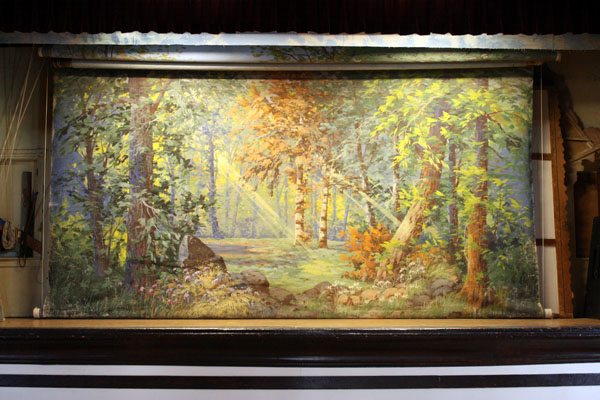
by Wendy Waszut-Barrett
Czech-American theatre scenery collections represent one enduring aspect of the Czech culture and a primary resource for cultural historians and theatre practitioners in the Midwest. They depict the aesthetic shift in stage design and scenic art during the late-nineteenth through mid-twentieth centuries. Whereas Scottish Rite theatres contain massive collections in state-of-the-art facilities that showcase dozens of Masonic scenes, Czech-America Sokol theatres contain much smaller collections that showcase both their European and American homelands. The front curtain for a Czech-American stage is always a landscape depicting the city of Prague. It beckons Czech immigrants to remember their homeland and the importance of the Prague National Theatre.
To understand the historical context from which Czech-American theatres emerged, one must understand the rapid development of nineteenth-century Czech communities in the midwestern region. It was after the formation of the Austro-Hungarian Empire in 1867 that a mass migration of Czech immigrants flooded into the United States. Major Czech settlements were established in Wisconsin, Minnesota, Iowa, Nebraska, South Dakota, Kansas, and Texas. By the 1880s many of these Czech-American communities founded chapters of Czech cultural organizations, such as Cesko-Slovansky Podporujici Spolek (CSPS), Zapadnf Cesko-Bratr ska Jednota (ZCBJ), and the Sokol, often immediately constructing public meeting facilities with designated performance areas. These ethnic halls often incorporated elevated theatre stages into their design, complete with roll-drop scenery collections for Czech dramatic productions and other community activities. In some larger communities, Sokol halls included a fly loft with a full set of stock scenery for professional theatre troupes to utilize when on tour.
Taken from the Slavic word for falcon, the Sokol movement was a social, cultural, and gymnastics organization founded in Prague during 1862. My first encounter with Czech scenery was at the St. Paul Sokol Hall. Located at 383 Michigan Street in St. Paul, Minnesota, this ethnic hall is the longest-serving Czech-Slovak cultural center in the United States with the oldest Czech theater and national hall in the State of Minnesota. I had the privilege of restoring their roll-drop collection nearly two decades ago. It consisted of a front curtain, two European street scenes, two American street scenes, a landscape scene, and a woods scene. In addition to these roll drops there were several painted flats that included wood tormentors, residential tormentors, a double-painted fancy/rustic interior box set, a standard interior box set, and a rustic cottage flat unit. William Victor Higgins (1884-1949), a local member, produced the painted scenery for the St. Paul Sokol stage. As a scenic artist, Higgins worked for a variety of notable studios, including Chicago’s Sosman & Landis Studio. He was internationally trained as a fine artist and became a key member of the Taos, New Mexico Society of Artists.
My most recent encounter with Sokol scenery was in March at the Cuba, Kansas, Czech Hall. During the fall of 2013, local residents 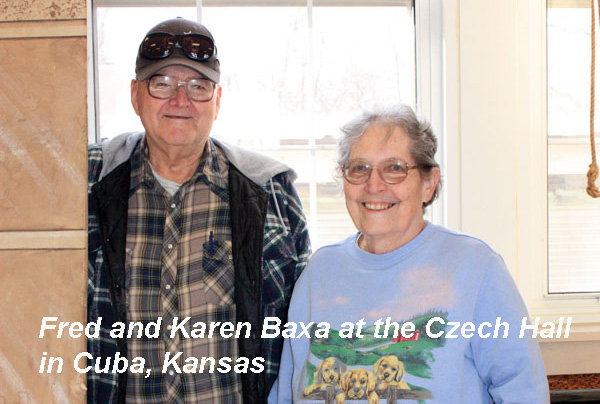 Fred and Karen Baxa contacted me concerning the restoration of their only painted scene – a roll drop depicting the city of Prague that was originally created for the Cuba Sokol during the 1920s. The composition depicts a street scene from Wenceslaus Square in Prague. St. Wenceslaus is the patron saint of Bohemia. The City of Cuba wanted a complete restoration of their prized possession in time for the annual Rock-A-Thon. This is fund-
Fred and Karen Baxa contacted me concerning the restoration of their only painted scene – a roll drop depicting the city of Prague that was originally created for the Cuba Sokol during the 1920s. The composition depicts a street scene from Wenceslaus Square in Prague. St. Wenceslaus is the patron saint of Bohemia. The City of Cuba wanted a complete restoration of their prized possession in time for the annual Rock-A-Thon. This is fund-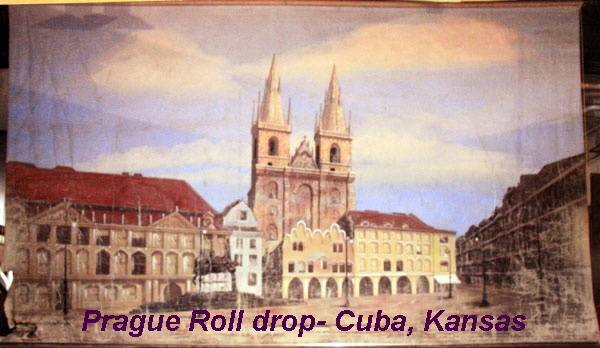 raising event where people rock in rocking chairs around the clock for a week in March. For a city of 156, this fundraiser generates approximately $35,000.00 each year. During the week-long event many diverse activities occur, but the highlights are on the Czech food, Polka dancing, Czech artifacts, and travelogues to the Prague.
raising event where people rock in rocking chairs around the clock for a week in March. For a city of 156, this fundraiser generates approximately $35,000.00 each year. During the week-long event many diverse activities occur, but the highlights are on the Czech food, Polka dancing, Czech artifacts, and travelogues to the Prague.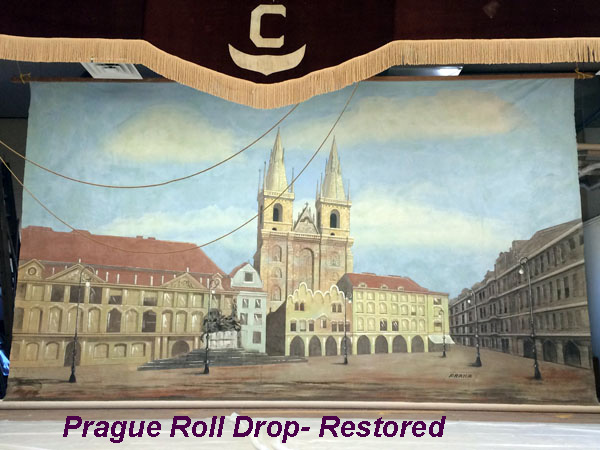
The city of Cuba was founded in 1868 by American southerners traveling westward after the Civil War. Receiving its name from a settler whom had once lived on the island of Cuba, many of the early settlers were Czech immigrants from Bohemia, bringing their cultural heritage and founding a local Sokol chapter. It was the Czech descendants, along with their self-proclaimed “Czech-mates” of these early settlers who welcomed me in March as I pulled up in front of the local café on main street. We had to break bread – or kolaches - before unloading my restoration studio supplies into the theatre.
In addition to a rather battered backdrop, there were several painted flats depicting interiors and woodland scenes that the locals immediately pulled out in addition to the Prague roll drop. Local residents explained that much of the damage occurr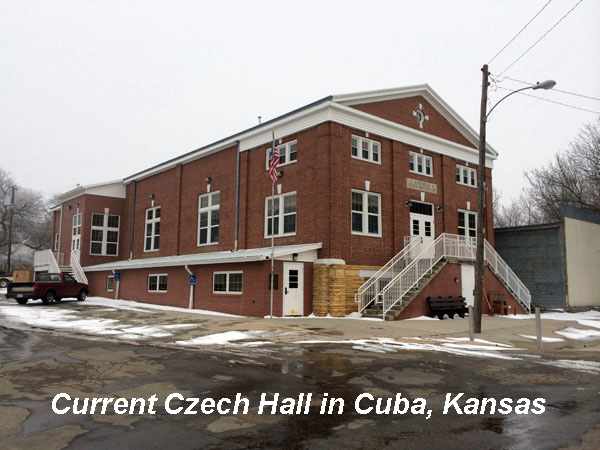 ed during wild Czech dances that were held each Saturday night. These massive events often ended in a full-fledged brawl that spilled out on main street. In addition to dances, roller skating, basketball games, and high school plays, were all performed in the Czech Hall. However, all of the events were so “rowdy” that many of the teenagers from neighboring French, German, and Swedish towns were prohibited from attending activities with the Czechs. Local residents also explained that the construction of the current and larger Czech building during 1930 had an equally exciting history.
ed during wild Czech dances that were held each Saturday night. These massive events often ended in a full-fledged brawl that spilled out on main street. In addition to dances, roller skating, basketball games, and high school plays, were all performed in the Czech Hall. However, all of the events were so “rowdy” that many of the teenagers from neighboring French, German, and Swedish towns were prohibited from attending activities with the Czechs. Local residents also explained that the construction of the current and larger Czech building during 1930 had an equally exciting history.
According to local residents, the original 1920s Sokol hall was destroyed by arson during February 1928 as a result of a “love triangle.” A banker’s wife from the neighboring town of Belleville, Kansas, fell in love with a local Czech resident and Sokol member. She was the Czech Hall’s pianist for many of the city’s events. After her husband discovered the amorous liaison, he set fire to the wooden structure. Fortunately, Cuba’s residents were able to rescue the Prague curtain from the burning building and install it after rebuilding their new theatre. There might be some truth to this tale as there were scorch marks on the top stage-right side of the roll-drop that I uncovered during cleaning. After the fire was extinguished, the banker was immediately apprehended and brought to the Belleville jail. Here, he was temporarily released to fill necessary medical prescriptions at the pharmacy across the street. The banker left the jail, entered the pharmacy, purchased some cyanide, and committed suicide in the nearby alley.
This colorful tale was one of many that I heard during my week in Cuba. One story included Laurence Welk’s performance at the Czech Hall and his unintentional stay with a local family when the 1936 blizzard prevented his departure. Other tales described various theories surrounding local mafia connections, Al Capone’s possible burial site, and the distribution of alcohol dropped by airplane into haystacks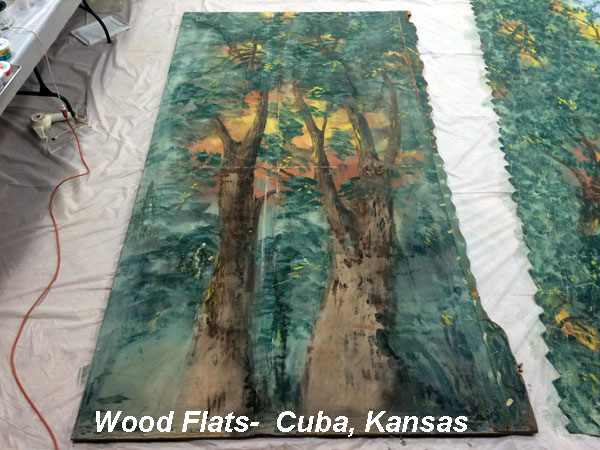 during Prohibition. These stories were my entertainment throughout the duration of the restoration project. Dozens of locals passed through the doors every hour to watch the restoration process and share their local history. This is one of many reasons that I enjoy completing restoration projects on site and working with local volunteers.
during Prohibition. These stories were my entertainment throughout the duration of the restoration project. Dozens of locals passed through the doors every hour to watch the restoration process and share their local history. This is one of many reasons that I enjoy completing restoration projects on site and working with local volunteers.
In regard to the historical significance of Cuba’s painted scenery, Jack Ballard and sons painted the scenery in Omaha, Nebraska. The backdrop was produced in the 1920s and the painted flats date slightly later in the 1930s. This evaluation is based on the type of fabric, coloration, and paint application. A United Scenic Artists stamp depicts that Jack Ballard was a member of Local 350. 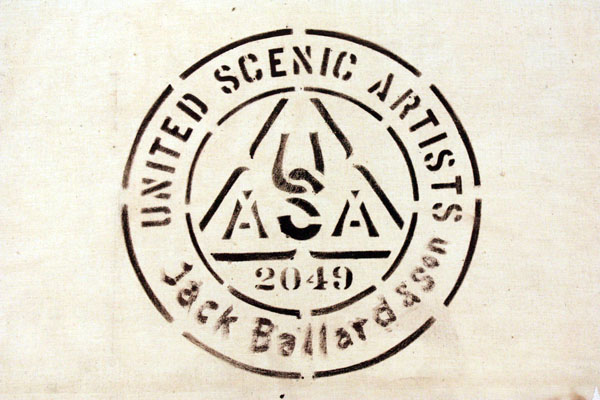 I discovered that Ballard’s home residence during this time was listed as Crete, Nebraska, a small town along the railway between Cuba, Kansas, and Lincoln, Nebraska. Crete is another Czech community supporting a Sokol hall and theatre space. Further research determined that Ballard produced many painted scenes for nearby Czech-American theatres, including the extravagant Sokol fly drop collection in Wilber, Nebraska – self-proclaimed Czech Capitol of the U.S.A.
I discovered that Ballard’s home residence during this time was listed as Crete, Nebraska, a small town along the railway between Cuba, Kansas, and Lincoln, Nebraska. Crete is another Czech community supporting a Sokol hall and theatre space. Further research determined that Ballard produced many painted scenes for nearby Czech-American theatres, including the extravagant Sokol fly drop collection in Wilber, Nebraska – self-proclaimed Czech Capitol of the U.S.A.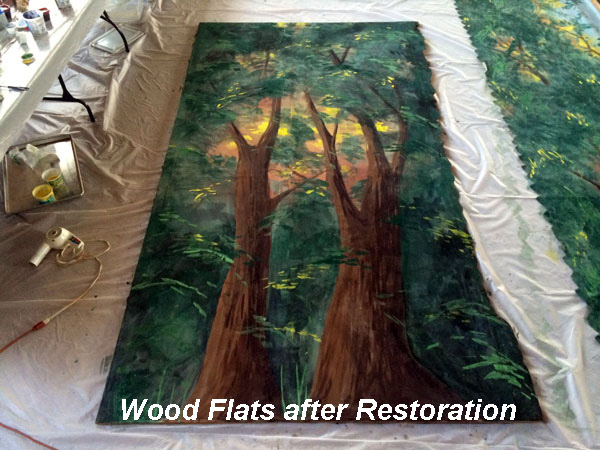
The Cuba backdrop and painted flats were produced with the dry-pigment paint system and “size water,” or diluted hide glue. During the restoration, I was able to determine several interesting facts in regard to the painting process. The drop was initially primed with whiting that had a weak binder. Unfortunately, the absence of a strong binder during its initial application will allow the whiting to “lift” from the fabric base and rise to the subsequent paint coats, all the way to the surface. In other words, if you take size water, or any liquid, and apply it with a brush to the painted surface in an attempt to stabilize the dusting pigment, a white “halo” will appear along with dye rings. This unfortunate aspect necessitates the use of Preval sprayers and a very soft brush technique.
In addition to the poorly applied whiting, the original sky color blue utilized a small amount of Dutch Pink that never quite dissolved into the cerulean, cobalt, and celestial mixture. The presence of paint granules suggested that they were not fully dissolved into the original mixture. Hidden granules on the surface allow a hidden color – like Dutch Pink - to “blossom” on the surface in an ugly splotch when any liquid is applied. This was another exciting challenge. To avoid this problem, the stabilization spray must not be allowed to fully penetrate the top coat of paint and reactivate these residual granules of color. Although it may seem tricky, one is able to minimize the appearance of all surface cracks, stabilize the dusting pigment, and avoid activating any fugitive color without creating one big ugly mess.
The most common problem that one encounters while restoring a painted scene is raw areas of muslin. This was apparent on the off-stage sides of the Prague drop. This type of deterioration is indicative of constant performer contact. On both stage-right and stage-left sides of the Prague drop, the original cartooning and paint had vanished, leaving no trace of the original composition. Furthermore, any historic photos available in Cuba failed to indicate the exact architectural elements for the scene. For appropriate architectural sources, coloration, and painting techniques, I referred to the University of Minnesota Performing Arts Scenery Collection database at https://www.lib.umn.edu/scrbm/paa/scenery. This is one of the many collections that Emeritus Professor Lance Brockman brought to the University of Minnesota during his tenure.
This online database is composed of three scenery collections: the Twin City Scenic Company collection (PA43), the Great Western Stage Equipment Company Collection (PA44), and the Holak collection (PA49). The collections uniquely document not only the scenic designs pf popular theatre, but also the aesthetic shift in scenic art during the late-nineteenth through early-twentieth centuries.
of three scenery collections: the Twin City Scenic Company collection (PA43), the Great Western Stage Equipment Company Collection (PA44), and the Holak collection (PA49). The collections uniquely document not only the scenic designs pf popular theatre, but also the aesthetic shift in scenic art during the late-nineteenth through early-twentieth centuries.
This site also allows me to bring theatre history and visual imagery to small rural communities, as well as metropolitan academic institutions. Its easy accessibility allows me to provide visual examples while explaining the significance of historic scenery collections across the country. Individuals are able to understand that their community centers are actually scenic art depositories, providing primary resources for both cultural historians and theatre practitioners. Whether these art depositories are stored in commercial, fraternal, or ethnic theatres, there is a reason to preserve this cultural artifact for not only the sake of American theatre history, but also for their own community’s heritage.
Wendy Waszut-Barrett is the founder of Bella Scena, LLC, a scenic studio that specializes in extant backdrop restoration and replacement. She has restored over 400 backdrops nationwide, including Masonic Theatre collections in New Mexico, North Dakota, Minnesota, Kansas, and Oklahoma. View the company website at http://www.bellascena.com/index.html
Below are additional drops from Czech ethnic halls showing a commercial street scene, a wooded scene, a blue "back" interior, a blue "front" interior, a fancy interior, a landscape, a european street scene and a residential street scene.
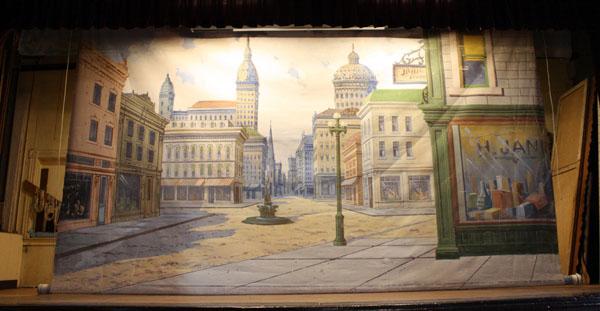 commercial street scene
commercial street scene
 wooded scene
wooded scene
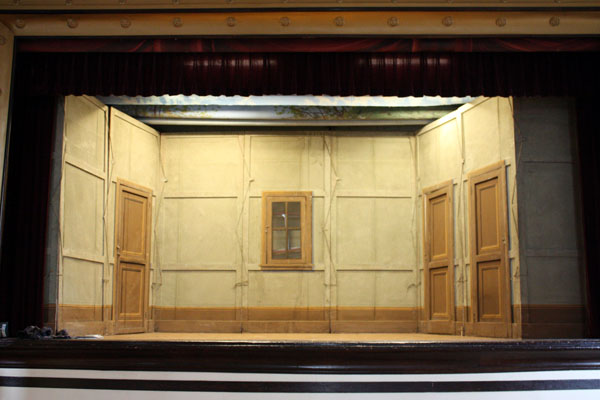 blue "back" interior
blue "back" interior
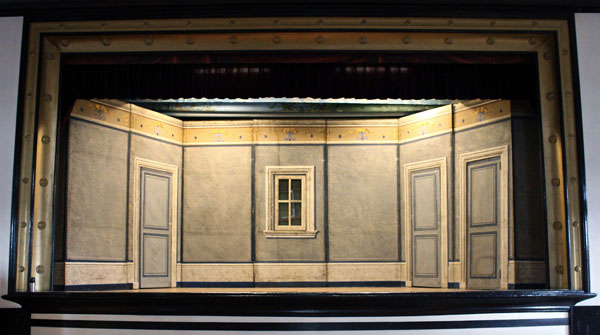 blue "front" interior
blue "front" interior
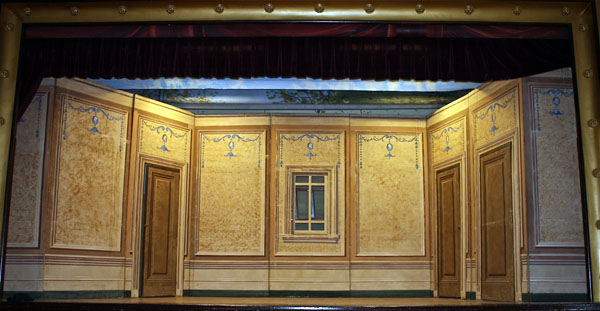 fancy interior
fancy interior
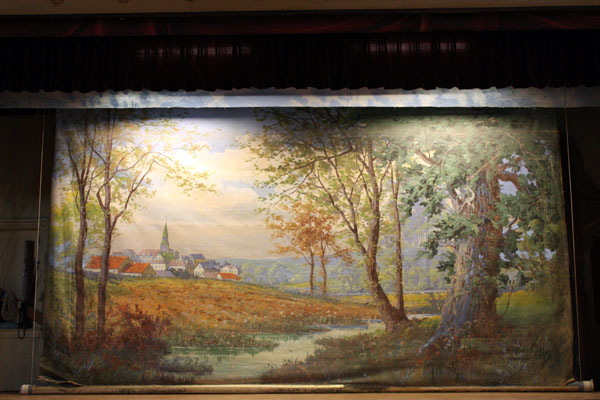 landscape
landscape
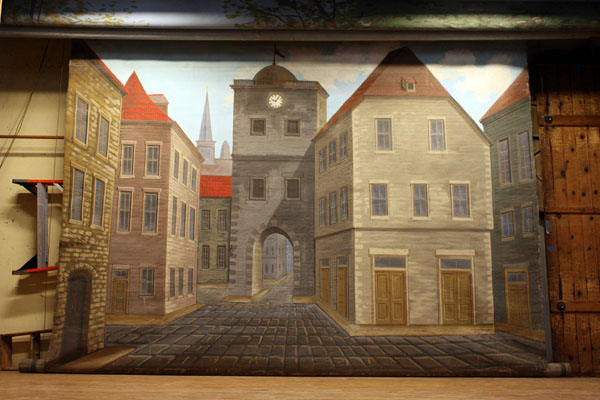 european street scene
european street scene
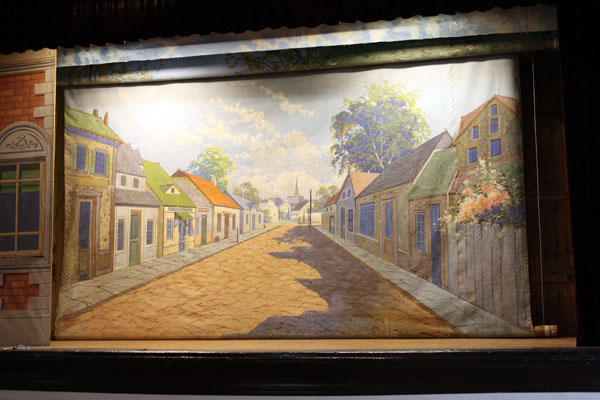
residential street scene
